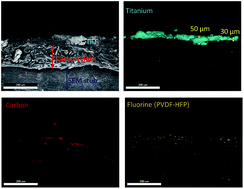Photocatalytic activity of an electrophoretically deposited composite titanium dioxide membrane using carbon cloth as a conducting substrate
Abstract
This is the first report where a polymer, namely poly(vinylidene fluoride-co-hexafluoropropylene) (PVDF–HFP), has been used as a binder together with the electrophoretic deposition process. PVDF–HFP provided mechanical stability and membrane flexibility and, at the same time, eliminated the leaching of the electrophoretically deposited TiO2 particles in the solution during the water treatment process. Electrophoretic deposition of TiO2 particles containing different weight percentages of PVDF–HFP were conducted and the required concentration of PVDF–HFP in the solution to prevent the leaching of TiO2 was established. The obtained material finds applications in photocatalytic water treatment, as investigated under simulated solar light in aqueous solutions using 4-nitrophenol, caffeine, acetaminophen and uracil as target molecules. Results indicated the complete removal of 4-nitrophenol after 24 hours, a degradation percentage above 80% of acetaminophen and uracil and 60% for caffeine. Photodegradation of pre-adsorbed methylene blue (MB) both under simulated solar radiation and visible light was successfully achieved in dry conditions as confirmed by diffusion reflectance spectra.


 Please wait while we load your content...
Please wait while we load your content...